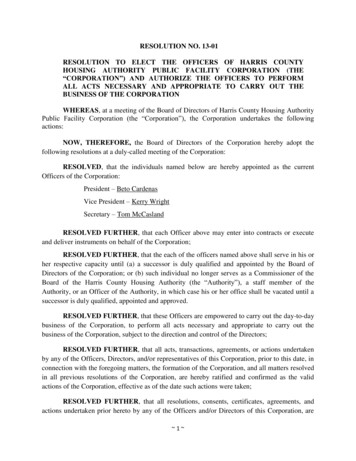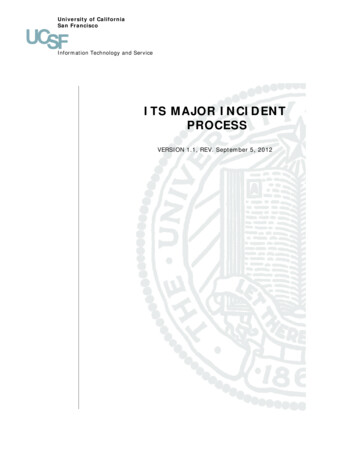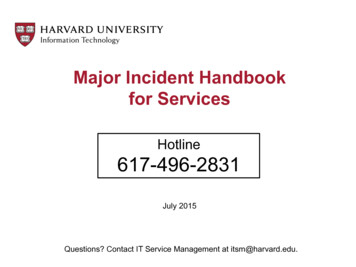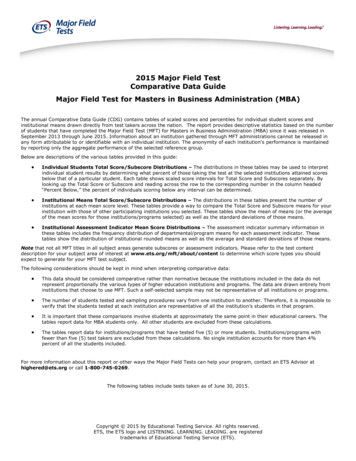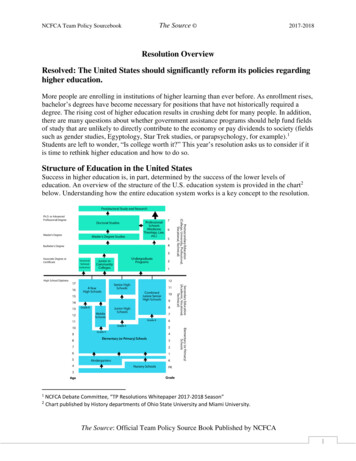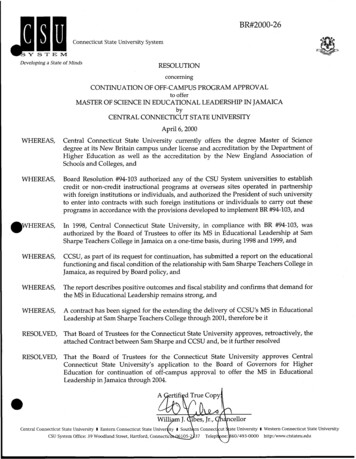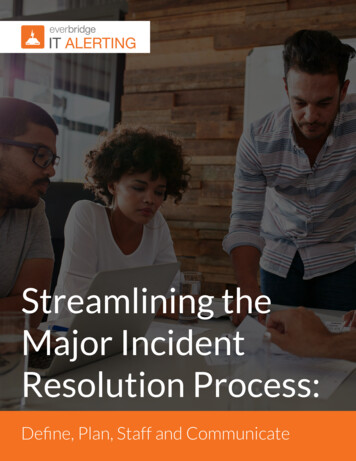
Transcription
Streamlining theMajor IncidentResolution Process:Define, Plan, Staff and Communicate
Streamlining the Major Incident Resolution Process:Define, Plan, Staff and CommunicateWhen a major IT incident occurs, planning and proper role delegation is essential for quick resolution. Forevery minute of system downtime, there are severe effects on the business: angry end users/customer, areduction in employee productivity, frustrated executives, and sometimes even impacted revenue – and forhospitals, it can affect patient safety. Not only should IT teams strive to resolve the major issue as quicklyas possible, they need to make sure they communicate with key stakeholders to prevent confusion and easeconcern. In this white paper we offer simple recommendations on planning, resource identification andcommunications to help streamline the major incident resolution process and limit the negative impacts ofmajor IT incidents on the business.Incident Management BasicsIt is important that we first mention the overall incident management process that IT teams typically followfor swift resolution. ITIL outlines a structured workflow that encourages efficiency and best results forboth IT teams and customers:11. Incident identification – When a user reports an incident via email, support call, network monitoringsoftware etc., the service desk must decide if the issue is truly an incident or if it’s a service request.Identification is first step in the life of an incident – a service request would set off a completelydifferent process known as a service request fulfillment.2. Incident logging – After the service desk has properly identified an incident, a ticket is logged andincludes information important to the case - user’s name and contact information, the incidentdescription, details, and the date and time of occurance.3. Incident categorization – The service desk must then assign a category and at least one subcategoryto each different incident. For example, an incident could be categorized as “hardware” with a subcategory of “hardware failure.” Categorization of incidents serves three different purposes: Provides a way for the service desk to sort and model incidents Allows for some automatic prioritization Offers accurate incident tracking4. Incident prioritization – An incident is then prioritized based on the details of the incident - its urgencyand impact. First, how urgent is this issue? How quickly is the resolution required? Second, what is theimpact? Or in other words, what is the extent of the incident and of the potential damage caused beforethe issue can be resolved? An incident can be classified as a low-priority, medium-priority or highpriority incident and each priority level requires a different level of response. We will revisit this topiclater in the white paper.www.ITalerting.com
5. Incident response – Once an incident is identified, categorized, and prioritized it is time for the servicedesk to coordinate resolution. This entails the initial diagnosis, escalation, investigation and diagnosis,recovery, and closure. After the incident is resolved, IT teams should also perform a root cause analysisand implement changes based on findings. Changes should be approved by the Change Advisory Boardand adopted as major incident response protocol. All incidents should be documented, analyzed andevaluated in order to identify areas for improvement and to help with future incident response.Major Incident ResponseThe standard process for incident resolution highlighted above in step 5 can be applied to most low-priorityIT incidents. But what happens when a high-priority incident strikes? As previously mentioned, major ITincidents have significant impact on the business and in order to limit the effects on stakeholders, endusers/customers, employee productivity and revenue, it is important to get the right people working on theissue as quickly as possible. Simon Morris, author for the ITSM Review, describes his experience with theway IT teams handle major incidents:“I actually found that in some cases all process and procedure went out of thewindow during a major incident, which has a horrible irony about it. Logicallyit would seem that this is the time that applying more process to the situationwould help I could see people pushing back against the idea of breaking outthe process-book because all that mattered was finding the technical fix andgetting the storage back up and running. – Simon Morris, ITSM Review”What steps can you take to avoid wasting time and streamline the major incident resolution process? Beloware four recommendations.1. Define a critical incident and map it to the overall incident prioritization system.According to 20000 Academy author Neven Zitek, a major incident is “a highest-impact, highesturgency incident affecting a large number of users, depriving the business of one or more crucialservices.”4 Zitek also mentions that according to ITIL, the definition of a major incident must be agreedupon by the business.4Each organization is different and will experience IT incidents with different levels of urgency andimpact. But, once the definition of a major incident is agreed on, it should “be mapped on the overallincident prioritization system – such that it can be dealt with through the major incident process.”2www.ITalerting.com
2. Define a clear and separate incident response process for critical incident resolutionCompanies have had to adopt procedures and best practices for major incident resolution separatefrom those used in standard incident resolution. ITIL suggests a brief but helpful way to approach majorincident planning, noting that once a definition of a major incident is agreed upon and mapped to theprioritization system, “a separate procedure, with shorter timescales and greater urgency, must be usedfor ‘major’ incidents.”2This separate procedure should be simple and automated. Information Age cites 7 areas for IT teams tofocus on when simplifying and automating the major incident resolution process, saving valuable time:51.2.3.4.5.6.7.Identifying the major incident (as highlighted in recommendation 1)Communicating with the impacted staff or business stakeholdersAssigning the right peopleTracking the major incident throughout its lifecycleEscalation upon breach of SLAsResolution and closureGeneration and analysis of reportsInformation Age also suggest that in the case of major incidents, IT teams should “adopt a noapproval process for solving major incidents.”5 Typically, resolution plans need to be blessed by uppermanagement and executive level staff but when time is of the essence, the approval process may hinderprogress in a way that adds to the negative impact on the olvewww.ITalerting.comAnalyze
Below is an example diagram from IT@Cornell appropriately titled the Central IT Major IncidentProcedure.6 The diagram maps the major incident resolution process within the organization. Althougheach major incident is going to present a different set of challenges, having a major incident plan andprocess in place saves time in the long run and helps limit the negative impact for any business.Example Map of Cornell University’s Incident Resolution ProcessSource: al IT Major Incident Procedure3. Identify the adequate resources and establish focus/priority levelWhether your organization has a dedicated incident resolution team headed by an incident manageror an ad hoc team of subject matter experts from various departments, the best resource for thejob should be working to solve the problem. Each member of the team should be trained on themajor incident process and should know their role. The table on the next page displays a roles andresponsibilities chart from IT@Cornell:6www.ITalerting.com
RoleMain ActivityCIOBeing informed of major incidents, may elect to engage a crisismanager.Crisis ManagerManages crisis resolution and recovery, crisis communications.EMCS (Energy Managementand Control System)Responsible for certain operational monitoring of CIT services from6 PM to 6 AM weekdays and all day on weekends and holidays.Incident ManagerManages incident resolution and recovery, engage CITcommunications; provide information for communications, may electto engage a crisis manager.IRT (Incident ResolutionTeam)Perform an initial investigation and diagnosis, identify any newproblem(s), resolve the incident and recover the service.IT Service ProviderResponsible for providing value to customers in the form of services.Service DeskManages incidents and service requests and handles communicationwith the users, the service desk “owns” any incident or requestmanagement tickets, responsible for certain operational monitoringof CIT services from 6 AM to 6 PM weekdays, excluding holidays.Service OwnerAct in the capacity of incident manager.SST (Service Support Team)Provide support for incident resolution, may form part of an incidentresolution team.Support On-CallEngage CIT Communications if the service owner has not, sendcommunications only if CIT communications is not available, if noother options are available, assist Service Owners in securing peoplefor the Incident Resolution Team.www.ITalerting.com
While the previous table is just an example of different roles and responsibilities involved in CornellUniversity’s Central IT Major Incident Procedure, a strict designation of who is responsible for whathelps to streamline the resolution process for any organization. Depending on the size of the IT teamand scope of its service management, roles and responsibilities will differ.“Smaller organizations will tend to aggregate a few roles into one job definition,while larger organizations will elaborate sub-roles for each major incidenttype, customer or technical expertise field. – 20000 Academy”3. Communication is Key – Get Resources Working on the Issue as Quickly as Possible and KeepRelevant People InformedCommunication throughout the various stages of the major incident lifecycle is fundamental instreamlining the resolution process. First, as stated in recommendation three, the proper resourcesneed to work on restoration but that is only half of it – they need to begin the process as quickly aspossible. But what if the team is dispersed across the building, the state, or even the country? Whatif certain team members use email while others are more likely to response to text? When a majorincident occurs, a communication method that quickly connects the right on-call IT personnel with theright information allows for quicker collaboration and therefore, faster resolution. IT teams should bearmed with a proper communication tool that allows facilitates this quick collaboration.Senior management must also be made aware of the IT incident so they can take the appropriatebusiness actions. Critical incidents might bring about procedure changes, resource reallocation andpriority shifts. Senior management will sometimes need to act quickly to implement policy changes inorder to limit the business impact of major IT incidents. The faster senior management is informed ofthe major incident, the faster they can make the proper business decisions.To even better streamline the resolution process, customer communication cannot be neglected. Oftentimes, the customer is omitted from the communication loop which has potential to create more backlog and overwhelm the service desk. Timely announcements, notifications and status updates shouldbe sent to all relevant stakeholders, including customers, on a regular cadence that will help alleviateconfusion and concern. Information Age suggests having a “dedicated line to respond to major incidentsimmediately and offer support to stakeholders” and using “the fastest means of communication, such astelephone calls, direct walk-ins, live chat, and remote control desktop, instead of relying on email.”5www.ITalerting.com
Optimizing CommunicationsWhat most companies do not recognize is that communication during the resolution process has thepotential to save quite a bit of money. Companies tend to see a huge return on their investment when theyhave a communication plan in place and a communication tool that allows IT teams to collaborate and keepstakeholders up to date.Everbridge IT Alerting helps IT teams streamline and automate the way IT teams communicate duringmajor IT incidents, in turn streamlining the resolution process. Everbridge’s cloud-based solution ensuresthat IT teams can quickly notify and communicate with their key members during major service disruptionswhen every minute counts. IT Alerting provides automated intelligent notifications, automatic escalationof alerts, on-call scheduling, mobile alerting, self-service mobile app and integrates with ITSM platforms,including ServiceNow and BMC Remedy. The solution connects the right on-call personnel with the rightinformation, so they can hop on a conference bridge quickly and fully focus on restoring service and limitingthe negative impact of incidents on end-user satisfaction and even revenue.To learn more about streamlining your critical incident resolution process with Everbridge IT Alerting //confluence.cornell.edu/display/itsmp/Central IT Major Incident Procedurewww.ITalerting.com
In this white paper we offer simple recommendations on planning, resource identification and . ITIL outlines a structured workflow that encourages efficiency and best results for both IT teams and custo
